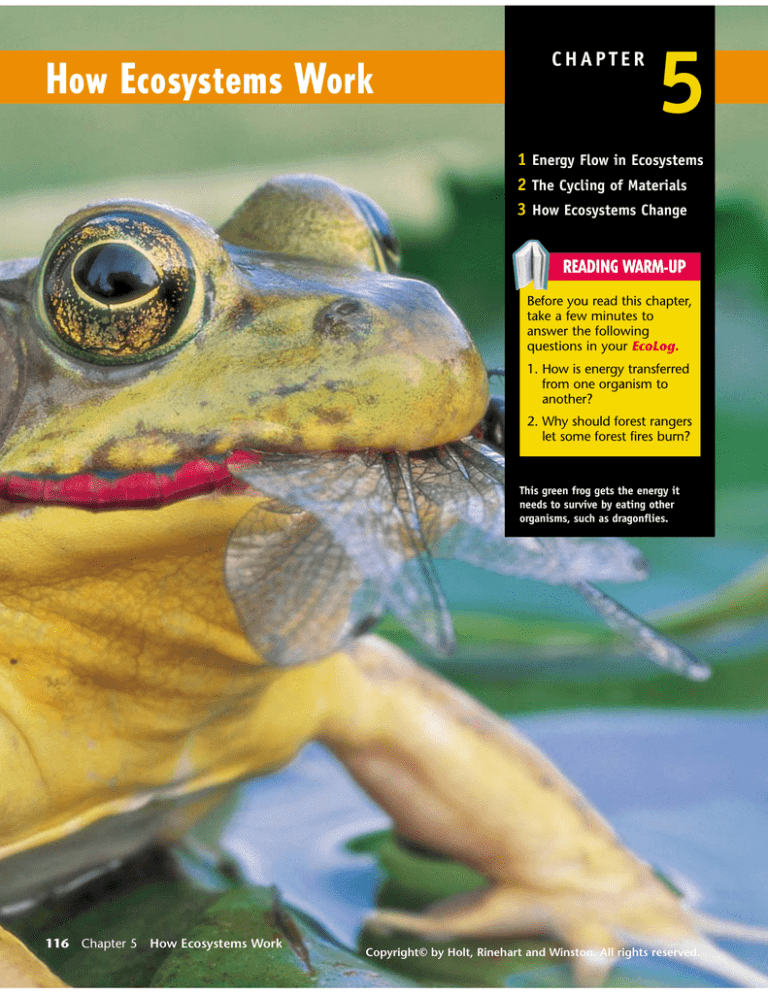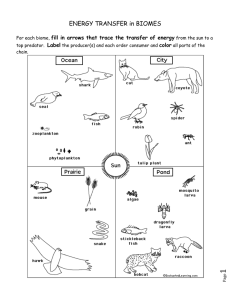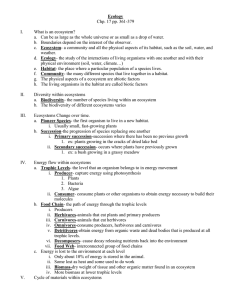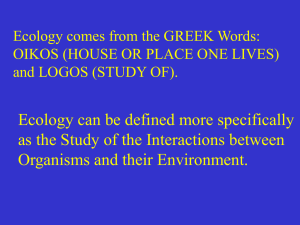
How Ecosystems Work
CHAPTER
5
1 Energy Flow in Ecosystems
2 The Cycling of Materials
3 How Ecosystems Change
READING WARM-UP
Before you read this chapter,
take a few minutes to
answer the following
questions in your EcoLog.
1. How is energy transferred
from one organism to
another?
2. Why should forest rangers
let some forest fires burn?
This green frog gets the energy it
needs to survive by eating other
organisms, such as dragonflies.
116 Chapter 5 How Ecosystems Work
Copyright© by Holt, Rinehart and Winston. All rights reserved.
SECTION 1
Energy Flow in Ecosystems
Just as a car cannot run without fuel, an organism cannot survive
without a constant supply of energy. Where does an organism’s
energy come from? The answer to that question depends on the
organism, but the ultimate source of energy for almost all organisms is the sun.
Objectives
Life Depends on the Sun
왘
Energy from the sun enters an ecosystem when a plant uses sunlight
to make sugar molecules by a process called photosynthesis.
During photosynthesis, plants, algae, and some bacteria capture
solar energy. Solar energy drives a series of chemical reactions
that require carbon dioxide and water, as shown in Figure 1. The
result of photosynthesis is the production of sugar molecules known
as carbohydrates. Carbohydrates are energy-rich molecules which
organisms use to carry out daily activities. As organisms consume
food and use energy from carbohydrates, the energy travels from
one organism to another. Plants, such as the sunflowers in Figure 2,
produce carbohydrates in their leaves. When an animal eats a plant,
some energy is transferred from the plant to the animal. Organisms
use this energy to move, grow, and reproduce.
왘 Describe how energy is transferred
왘
왘
왘
from the sun to producers and
then to consumers.
Describe one way in which consumers depend on producers.
List two types of consumers.
Explain how energy transfer in a
food web is more complex than
energy transfer in a food chain.
Explain why an energy pyramid is
a representation of trophic levels.
Key Terms
photosynthesis
producer
consumer
decomposer
cellular respiration
food chain
food web
trophic level
Figure 1 왘 During photosynthesis,
plants use carbon dioxide, water, and
solar energy to make carbohydrates
and oxygen.
Figure 2 왘 The cells in the leaves of
these sunflowers contain a green
chemical called chlorophyll. Chlorophyll helps plants trap energy from
the sun to produce energy-rich
carbohydrates.
Copyright© by Holt, Rinehart and Winston. All rights reserved.
Energy Flow in Ecosystems 117
Figure 3 왘 Transfer of Energy
Almost all organisms depend on the
sun for energy. Plants like the clover
shown above get energy from the
sun. Animals like the rabbit and
coyote get their energy by eating
other organisms.
Figure 4 왘 The tube worms (above)
depend on bacteria that live inside
them to survive. The bacteria (right)
use energy from hydrogen sulfide to
make their own food.
118 Chapter 5 How Ecosystems Work
From Producers to Consumers When a rabbit eats a clover plant,
the rabbit gets energy from the carbohydrates the clover plant made
through photosynthesis. If a coyote eats the rabbit, some of the
energy is transferred from the rabbit to the coyote. In the example
shown in Figure 3, the clover is the producer. A producer is an
organism that makes its own food. Producers are also called
autotrophs, self-feeders. Both the rabbit and the coyote are
consumers, organisms that get their energy by eating other organisms. Consumers are also called heterotrophs, other-feeders. In the
example shown in Figure 3, the clover, rabbit, and coyote get their
energy from the sun. Some producers get energy directly from the
sun by absorbing it through their leaves. Consumers get energy
indirectly from the sun by eating producers or other consumers.
An Exception to the Rule: Deep-Ocean Ecosystems In 1977,
scientists discovered areas on the bottom of the ocean off the coast
of Ecuador that were teeming with life, even though
sunlight did not reach the bottom of the ocean.
The scientists found large communities of
worms, clams, crabs, mussels, and barnacles
living near thermal vents in the ocean floor.
These deep-ocean communities exist in total
darkness, where photosynthesis cannot occur.
So where do these organisms get their energy?
Bacteria, such as those pictured in Figure 4, live
in some of these organisms and use hydrogen sulfide to make their own food. Hydrogen sulfide is present
in the hot water that escapes from the cracks in the ocean floor.
Therefore, the bacteria are producers that can make food without
sunlight. These bacteria are eaten by the other underwater organisms and thus support a thriving ecosystem.
Copyright© by Holt, Rinehart and Winston. All rights reserved.
MATHPRACTICE
What Eats What
Table 1 below classifies organisms by the source of their energy.
Consumers that eat only producers are called herbivores, or plant
eaters. Rabbits are herbivores and so are cows, sheep, deer, grasshoppers, and many other animals. Consumers, such as lions and
hawks, that eat only other consumers are called carnivores, or
flesh eaters. You already know that humans are consumers, but
what kind of consumers are we? Because most humans eat both
plants and animals, we are called omnivores, or eaters of all.
Bears, pigs, and cockroaches are other examples of omnivores.
Some consumers get their food by breaking down dead organisms
and are called decomposers. Bacteria and fungi are examples of
decomposers. The decomposers allow the nutrients in the rotting
material to return to the soil, water, and air.
A Meal Fit for a Grizzly
Bear Grizzly bears are
omnivores that can eat up to
15 percent of their body weight
per day when eating salmon and
up to 33 percent of their body
weight when eating fruits and
other vegetation. How many
pounds of salmon can a 200 lb
grizzly bear eat in one day? How
many pounds of fruits and other
vegetation can the same bear eat
in one day?
Table 1 왔
What Eats What in an Ecosystem
Energy source
Examples
Producer
makes its own food
through photosynthesis
or chemical sources
grasses, ferns, cactuses,
flowering plants, trees,
algae, and some bacteria
Consumer
gets energy by eating
producers or other
consumers
mice, starfish, elephants,
turtles, humans, and ants
Types of Consumers in an Ecosystem
Energy source
Examples
Herbivore
producers
cows, sheep, deer, and
grasshoppers
Carnivore
other consumers
lions, hawks, snakes,
spiders, sharks, alligators,
and whales
Omnivore
both producers
and consumers
bears, pigs, gorillas, rats,
raccoons, cockroaches,
some insects, and
humans
Decomposer
breaks down dead
organisms in an
ecosystem and returns
nutrients to soil, water,
and air
fungi and bacteria
Copyright© by Holt, Rinehart and Winston. All rights reserved.
Figure 5 왘 Bears, such as the grizzly
bear below, are omnivores. Grizzly
bears eat other consumers, such as
salmon, but they also eat various
plants.
Section 1 Energy Flow in Ecosystems 119
Connection to
Cellular Respiration: Burning the Fuel
Chemistry
So far, you have learned how organisms get energy. But how do
they use the energy they get? To understand the process, use
yourself as an example. Suppose you have just eaten a large meal.
The food you ate contains a lot of energy. Your body gets the
energy out of the food by using the oxygen you breathe to break
down the food. By breaking down the food, your body obtains
the energy stored in the food.
The process of breaking down food to yield energy is called
cellular respiration, which occurs inside the cells of most organisms. This process is different from respiration, which is another
name for breathing. During cellular respiration, cells absorb oxygen and use it to release energy from food. As you can see in
Figure 6, the chemical equation for cellular respiration is essentially the reverse of the equation for photosynthesis. During cellular respiration, sugar and oxygen combine to yield carbon
dioxide, water, and, most importantly, energy.
Chemical Equations Chemical
reactions are represented by
chemical equations. A chemical
equation is a shorthand description of a chemical reaction using
chemical formulas and symbols.
The starting materials in a reaction
are called reactants, and the substances formed from a reaction
are called products. The number of
atoms of each element in the reactants equals the number of atoms
of those elements in the products
to make a balanced equation.
Figure 6 왘 Through cellular respira-
tion, cells use glucose and oxygen
to produce carbon dioxide, water,
and energy.
DDT in an Aquatic Food Chain
In the 1950s and 1960s, something
strange was happening in the estuaries near Long Island Sound, near
New York and Connecticut. Birds of
prey, such as ospreys and eagles,
that fed on fish in the estuaries had
high concentrations of the pesticide
DDT in their bodies. But when the
water in the estuary was tested, it
had low concentrations of DDT.
What accounted for the high
levels of DDT in the birds? Poisons
that dissolve in fat, such as DDT, can
become more concentrated as they
move up a food chain in a process
called biological magnification. When
the pesticide enters the water, algae
and bacteria take in the poison.
When fish eat the algae and bacteria,
the poison dissolves into the fat of
the fish rather than diffusing back
into the water. Each time a bird feeds
on a fish, the bird accumulates more
DDT in its fatty tissues. In some estuaries on Long Island Sound, DDT
concentrations in fatty tissues of
organisms were magnified almost 10
million times from the bottom to the
왘 A high concentration of DDT decreases the thickness and the strength of
eggshells of many birds of prey.
120 Chapter 5 How Ecosystems Work
Copyright© by Holt, Rinehart and Winston. All rights reserved.
You use a part of the energy you obtained through cellular
respiration to carry out your daily activities. Every time you walk,
breathe, read a book, think, or play a sport, you use energy. The
energy you obtain is also used to make more body tissues and to
fight diseases so that you grow and stay healthy. Excess energy you
obtain is stored as fat or sugar. All living things use cellular respiration to get the energy they need from food molecules. Even organisms that make their own food through photosynthesis use cellular
respiration to obtain energy from the carbohydrates they produce.
Energy Transfer
Each time one organism eats another organism, a transfer of energy
occurs. We can trace the transfer of energy as it travels through
an ecosystem by studying food chains, food webs, and trophic
levels. Food chains, food webs, and trophic levels can tell us how
energy is transferred as well as how much energy is transferred
between organisms in an ecosystem. Studying the paths of energy
between organisms can also tell us which organisms in an ecosystem depend on other organisms to survive.
Connection to
Biology
Calories from Food The substances your body needs to survive
and grow come from food. Carbohydrates, proteins, and fats are
major sources of energy for the
body. The energy content of food
can be found by burning a dry
food sample in a special calorimeter. Both carbohydrates and proteins provide 4 Calories (Cal) of
energy per gram, while fats provide 9 Cal of energy per gram.
nant and in 1972 banned its sale
except in emergencies. The aquatic
food chains immediately started to
recover, and the populations of
ospreys and eagles started to grow.
Food chains are still not free of
DDT. DDT is still legal in some countries, where it is used in large quantities to eliminate mosquitoes that
carry the disease malaria. As
a result, migratory birds may be
exposed to DDT while wintering in
locations outside the United States.
CRITICAL THINKING
왘 Poisons such as DDT have the greatest affect on organisms at the top
of food chains. For example, the osprey shown here would have a greater
concentration of DDT in its body than the perch it’s about to eat.
top of the food chain. Large concentrations of DDT may kill an organism,
weaken its immune system, cause
deformities, or impair its ability to
reproduce. DDT can also weaken the
shells of bird eggs. When eggs break
too soon, bird embryos die. Therefore, the effects of these chemicals
cause a tremendous drop in the population of carnivorous bird species.
The U.S. government recognized
DDT as an environmental contami-
Copyright© by Holt, Rinehart and Winston. All rights reserved.
1. Analyzing Processes DDT
does not dissolve readily in water. If
it did, how would the accumulation
of the pesticide in organisms be
affected?
2. Evaluating Information Even
though DDT is harmful to the environment, why is it still used in some
countries?
Section 1 Energy Flow in Ecosystems 121
Figure 7 왘 Energy is transferred
from one organism to another in a
food chain, such as the one shown
below. Algae are the producers in
this ocean food chain.
Food Chains and Food Webs A food chain is a sequence in which
energy is transferred from one organism to the next as each organism eats another organism. Figure 7 shows a typical food chain in an
ocean ecosystem. Algae are eaten by krill, which are eaten by cod.
The cod are eaten by leopard seals, which are eaten by killer whales.
Energy flow in an ecosystem is much more complicated than
energy flow in a simple food chain. Ecosystems almost always
contain many more species than a single food chain contains. In
addition, most organisms, including humans, eat more than one
kind of food. So a food web, such as the one shown in Figure 8,
includes more organisms and multiple food chains linked
together. A food web shows many feeding relationships that are
possible in an ecosystem. Notice that the food chain is just one
strand in the larger food web.
Trophic Levels Each step in the transfer of energy through a food
chain or food web in an ecosystem is known as a trophic level. In
Figure 8, the algae are in the bottom trophic level, the krill are in
the next level, and so on. Each time energy is transferred from one
organism to another, some of the energy is lost as heat and less
energy is available to organisms at the next trophic level. Some of
this energy is lost during cellular respiration. Organisms use much
of the remaining energy to carry out the functions of living, such as
producing new cells, regulating body temperature, and moving
Figure 8 왘 This food web shows
how the largest organisms, such as a
killer whale, depend on the smallest
organisms, such as algae, in an ocean
ecosystem.
122 Chapter 5 How Ecosystems Work
Copyright© by Holt, Rinehart and Winston. All rights reserved.
around. About 90 percent of the energy at each trophic level is
used in these ways. The remaining 10 percent of the energy
becomes part of the organism’s body and is stored in its molecules.
This 10 percent that is stored is all that is available to the next
trophic level when one organism consumes another organism.
Figure 9 왘 This energy pyramid
shows how energy is lost from one
trophic level to the next. The grass at
the bottom level stores 1,000 times
more energy than the hawk at the
top level.
Energy Pyramids One way to visualize the loss of energy from
one trophic level to the next trophic level is to draw an energy
pyramid like the one shown in Figure 9. Each layer in the energy
pyramid represents one trophic level. Producers form the base of
the pyramid, the lowest trophic level, which contains the most
energy. Herbivores contain less energy and make up the second
level. Carnivores that feed on herbivores form the next level,
and carnivores that feed on other carnivores make up the
top level. Organisms in the upper trophic levels store less
energy than both herbivores and producers. A pyramid
is a good way to illustrate trophic levels because the
pyramid becomes smaller toward the top, where
less energy is available.
How Energy Loss Affects an Ecosystem The
decreased amount of energy at each trophic level affects the
organization of an ecosystem. First, the energy loss is usually due
to a smaller number of organisms at the higher trophic levels. For
example, zebras and other herbivores outnumber lions on the
African savanna by about 1,000 to 1. In this example, there simply are not enough herbivores to support more carnivores.
Second, the loss of energy from trophic level to trophic level
limits the number of trophic levels in an ecosystem. Ecosystems
rarely have more than four or five trophic levels because the ecosystem does not have enough energy left to support higher levels.
For example, a lion typically needs up to 250 km2 of land to hunt
for food. Therefore, an animal that feeds on lions would have to
expend a lot of energy to harvest the small amount of energy
available at the top trophic level. The organisms that do feed on
organisms at the top trophic level are usually small, such as parasitic worms and fleas that require a very small amount of energy.
SECTION 1
www.scilinks.org
Topic: Food Chains, Food
Webs, and Trophic Levels
SciLinks code: HE4043
Review
1. Describe how energy is transferred from one organism to another.
2. Describe the role that producers play in an
ecosystem.
3. Explain the difference between an herbivore and an
omnivore.
4. Compare energy transfer in a food chain to energy
transfer in a food web.
Copyright© by Holt, Rinehart and Winston. All rights reserved.
CRITICAL THINKING
5. Interpreting Graphics Look at Figure 8. What
feeding relationships does the crabeater seal have?
6. Inferring Relationships Read the paragraph
under the heading, “Trophic Levels” in this section.
Could more people be supported by 20 acres of land
if they ate only plants instead of both plants and animals? Explain your answer. READING SKILLS
Section 1 Energy Flow in Ecosystems 123







